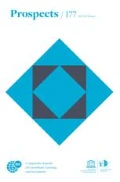References
L.W. Anderson D.W. Ryan B.J. Shapiro (1989) The IEA classroom environment study Pergamon Press Oxford, UK
D.P. Baker B. Goesling G.K. LeTendre (2002) ArticleTitleSocio-economic status, school quality, and national economic development: a cross-national analysis of the “Heyneman-Loxley Effect” on mathematics and science achievement Comparative education review 46 IssueID3 291–312
Boardman, A.E.; Murnane, R.J. 1979. Using panel data to improve estimates of the determinants of educational attainment. Sociology of education (Washington, DC), vol. 52, April, p. 113–21
W.R. Borg (1980) Time and school learning C. Denham A. Lieberman (Eds) Time to learn National Institute of Education Washington, DC 33–72
G. Cawelti (Eds) (1999) Handbook of research on improving student achievement Educational Research Service Arlington, VA
G.J. Cizek (1997) Learning, achievement, and assessment: constructs at a crossroads G.D. Phye (Eds) Handbook of classroom assessment Academic Press San Diego, CA 1–32
J.P. Farrell (1989) View from the developing world M. Holmes (Eds) Educational policy for effective schools Teachers College Press New York, NY 53–70
C.W. Fisher D.C. Berliner (Eds) (1985) Perspectives on instructional time Longman New York, NY
B. Fuller (1987) ArticleTitleWhat school factors raise achievement in the Third World Review of educational research 57 255–92
B. Fuller P. Clarke (1994) ArticleTitleRaising school effects while ignoring culture? Local conditions and the influence of classroom tools, rules, and pedagogy Review of educational research 64 IssueID1 119–57
R. Glaser E. Silver (1994) ArticleTitleAssessment, teaching, and instruction: retrospect and prospect Review of research in education 20 393–419
P. Glewwe H. Jacoby (1992) Estimating the determinants of cognitive achievement in low-income countries: the case of Ghana World Bank Washington, DC
C.V. Good (Eds) (1973) Dictionary of education EditionNumber3rd McGraw-Hill New York, NY
J.E. Griffith et al. (1994) Understanding the performance of U.S. students on international assessments. Education policy issues: statistical perspectives National Center for Educational Statistics Washington, DC
S. Heyneman (1993) ArticleTitleQuantity, quality and source Comparative education review 37 372–88
S. Heyneman W. Loxley (1983) ArticleTitleThe effect of primary school quality on academic achievement across twenty-nine high and low-income countries American journal of sociology 88 1162–94
Holsinger, D.B. 1982. Time, content and expectations as predictors of school achievement in the USA and other developed countries: a review of IEA evidence. Paper presented at a meeting of the National Commission on Excellence in Education, New York, NY, September 1982
S.H. Huyvaert (1998) Time is of the essence: learning in schools Allyn & Bacon Needham Heights, MA
E. Jimenez et al. (1991) ArticleTitleSchool effects and costs for private and public schools in the Dominican Republic International journal of educational research 15 IssueID5 393–410
N.L. Karweit (1976) ArticleTitleA reanalysis of the effect of quantity of schooling on achievement Sociology of education 49 236–246
A. Kostakis (1987) ArticleTitleDifferences among school outputs and educational production functions Sociology of education 60 IssueID4 232–41
R.W. Larsen (1989) ArticleTitleBeeping children and adolescents: a method for studying time use and daily experiences Journal of youth and adolescence 18 511–30
V.E. Lee J.B. Smith R.G. Croninger (1997) ArticleTitleHow high school organization influences the equitable distribution of learning in mathematics and science Sociology of education 70 IssueID2 128–50
InstitutionalAuthorNameNational Education Commission on Time and Learning (1994) Prisoners of time U.S. Government Printing Office Washington, DC
S. Nelson (1990) Instructional time as a factor in increasing student achievement Northwest Regional Educational Laboratory Portland, OR
Office of Educational Research and Improvement (OERI). 1986. Time spent on mathematics instruction and homework by Japanese and U.S. 13-year-old-students. OERI bulletin (Laurel, MD)
G. Pill (1972) ArticleTitleU.S. schedule and British timetable: a comparison of concepts Journal of general education 24 IssueID1 37–50
Poe, J.; Cohen, J.S. 1998. School’s out, but not for long. Chicago Tribune (Chicago, IL), June 19, p. A1
B. Smith (2000) ArticleTitleQuantity matters: annual instructional time in an urban school system Educational administration quarterly 36 IssueID5 652–82
A.B. Sorenson M.T. Hallinan (1977) ArticleTitleA reconceptualization of school effects Sociology of education 50 IssueID4 273–89
Stevenson, H.W. 1983. Making the grade: school achievement in Japan, Taiwan, and the United States. Annual Report of the Center for Advanced Study in the Behavioural Sciences, p. 41–51. Stanford, CA: Center for Advanced Study in the Behavioural Sciences
Tedesco, L.A., et al. 1979. School and classroom processes: a secondary analysis. Paper presented at the annual meeting of the American Educational Research Association, San Francisco, CA, April 1979
S. Veenman et al. (1985) ArticleTitleActive learning time in mixed age classes Educational studies 11 IssueID3 171–80
H.J. Walberg (1988) ArticleTitleSynthesis of research on time and learning Educational leadership 45 IssueID6 76–85
F.C. Wayne H.J. Walberg (1980) ArticleTitleLearning as a function of time The journal of educational research 20 183–94
Yair, G. 2000a. Not just about time: instructional practices and productive time in school. Educational administration quarterly (Thousand Oaks, CA), vol. 36, no. 4, p. 485–512.
Yair, G. 2000b. Reforming motivation: how the structure of instruction affects students’ learning experiences. British educational research journal (Abingdon, UK), vol. 26, no. 2, p. 191–210
Author information
Authors and Affiliations
Corresponding author
Additional information
Original language: English
David Baker (United States of America)
Ph.D., Sociology, Johns Hopkins University. Professor of Education and Sociology at the Pennsylvania State University and Associate Director of the Social Science Research Institute. His research interests include education, stratification/mobility and organizations (formal/complex). In 2003 he was awarded the Outstanding International Study of the Year Award from the American Education Research Association jointly with Gerry LeTendre and Brian Goesling. E-mail: dpb4@psu.edu.
Rodrigo Fabrega, Claudia Galindo and Jacob Mishook are doctoral students working in the Department of Education Policy Studies, Pennsylvania State University, University Park, PA.
About this article
Cite this article
Baker, D.P., Fabrega, R., Galindo, C. et al. Instructional Time and National Achievement: Cross-National Evidence. Prospects 34, 311–334 (2004). https://doi.org/10.1007/s11125-004-5310-1
Issue Date:
DOI: https://doi.org/10.1007/s11125-004-5310-1

